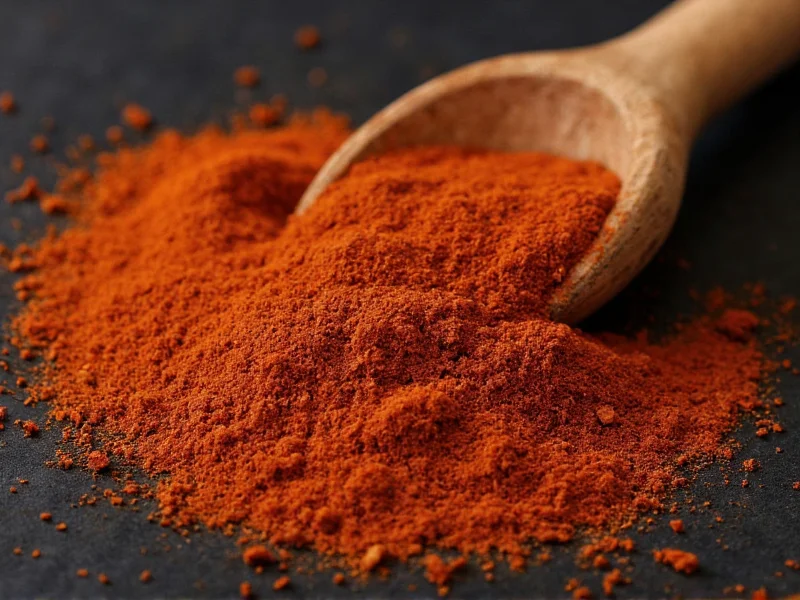Mace spice appears as delicate, vibrant orange-red to golden-yellow lacy membranes that wrap around nutmeg seeds. When whole, these "blades" or "arils" are thin, brittle, and resemble crumpled tissue paper, typically measuring 2.5-5 cm long. Ground mace forms a fine powder ranging from pale yellow to deep saffron in color, with a distinctive warm, slightly sweet aroma.
Mace, the often-overlooked cousin of nutmeg, presents a striking visual profile that sets it apart from other common spices. This aromatic spice originates from the same fruit as nutmeg but represents a completely different part of the plant. Understanding mace's appearance helps cooks, shoppers, and culinary enthusiasts properly identify and utilize this valuable seasoning.
Physical Characteristics of Whole Mace
Whole mace consists of the dried aril—the lacy, web-like covering that surrounds the nutmeg seed inside the fruit of the Myristica fragrans tree. When harvested, these arils are bright orange-red, gradually changing to a more golden-yellow hue as they dry. Each piece resembles a delicate, crinkled ribbon or blade, typically:- Measuring 1-2 inches (2.5-5 cm) in length
- Exhibiting a translucent, papery texture
- Displaying a distinctive network of fine veins
- Maintaining flexibility when fresh, becoming brittle when fully dried
| Form | Color | Texture | Size |
|---|---|---|---|
| Fresh mace | Bright orange-red | Flexible, slightly moist | 2.5-5 cm long |
| Dried whole mace | Golden yellow to pale orange | Brittle, papery | Retains original shape |
| Ground mace | Pale yellow to deep saffron | Fine powder | N/A |
Mace vs. Nutmeg: Visual Comparison
Many people confuse mace with nutmeg since they come from the same fruit, but their appearances differ significantly. While nutmeg is the hard, brown, oval seed inside the fruit, mace is the lacy red-orange covering that surrounds it. Imagine an avocado pit—nutmeg would be the pit itself, while mace would be the thin brown skin covering the pit. When shopping for these spices, remember:- Nutmeg appears as small, hard, brown ovals (whole) or beige powder (ground)
- Mace shows as delicate, crinkled orange-red pieces (whole) or yellow-orange powder (ground)
- Ground mace has a noticeably brighter, more golden color than ground nutmeg
How Processing Affects Mace's Appearance
The appearance of mace changes through its processing stages: Harvest stage: The arils are bright red-orange and somewhat pliable when first removed from the fruit. Drying process: As mace dries (typically over 10-14 days), it transforms from bright red to a more subdued golden yellow. Properly dried mace maintains its distinctive lacy structure without becoming overly brittle. Ground form: When milled into powder, mace loses its delicate structure but retains its characteristic golden-yellow color. High-quality ground mace should appear uniform in color without dark specks or discoloration.Identifying Quality Mace
When evaluating mace quality based on appearance, look for these characteristics:- Color consistency: Premium mace displays a uniform golden-yellow hue without dark spots or patches
- Structural integrity: Whole mace blades should maintain their lacy structure without excessive fragmentation
- Moisture content: Properly dried mace should feel dry and brittle, not flexible or damp
- Powder quality: Ground mace should flow freely without clumping and show consistent color throughout
Practical Identification Tips
For home cooks and shoppers trying to identify mace:- Examine whole mace against light—authentic pieces should appear somewhat translucent with visible veining
- Compare with nutmeg—mace should be distinctly more orange-yellow while nutmeg is brown
- Check ground mace against turmeric—while both are yellow, mace has a more golden-orange tone while turmeric is brighter yellow
- Smell the spice—mace has a warm, slightly sweet, floral aroma distinct from nutmeg's more intense, woody scent
Common Visual Misidentifications
Mace is frequently confused with several other spices:- Turmeric: Both are yellow, but turmeric powder is brighter and more intense yellow, while mace has orange undertones
- Saffron: Both have red-orange hues, but saffron consists of thin red threads, not lacy membranes
- Paprika: Similar color range, but paprika lacks mace's distinctive floral aroma and has a more brick-red color
Geographical Variations in Appearance
Mace from different growing regions shows subtle visual differences:- Indonesian mace: Typically darker orange with slightly thicker blades
- Grenadian mace: Known for its bright golden color and delicate structure
- Sri Lankan mace: Often displays a more pronounced reddish hue
Storage Impact on Appearance
Proper storage maintains mace's visual characteristics:- Light exposure causes fading—mace stored in clear containers loses its vibrant color
- Moisture leads to clumping in ground mace and brittleness in whole blades
- Heat accelerates color degradation—golden mace turns dull brown when overheated
Visual Indicators of Freshness
When assessing mace for freshness, pay attention to these visual cues:- Bright, vibrant color indicates recent processing
- Whole blades that maintain flexibility (without being moist) suggest proper drying
- Avoid mace with dark spots, which indicate age or improper storage
- Ground mace should have a uniform color without grayish or brownish patches
Using Visual Identification in Cooking
The appearance of mace provides practical cooking benefits:- Whole blades can be visually identified in dishes and removed before serving
- The distinctive color enhances light-colored sauces and baked goods without darkening them like nutmeg might
- Cooks can visually gauge proper mace quantity—1-2 whole blades or ¼-½ teaspoon ground mace typically suffices for most recipes











 浙公网安备
33010002000092号
浙公网安备
33010002000092号 浙B2-20120091-4
浙B2-20120091-4